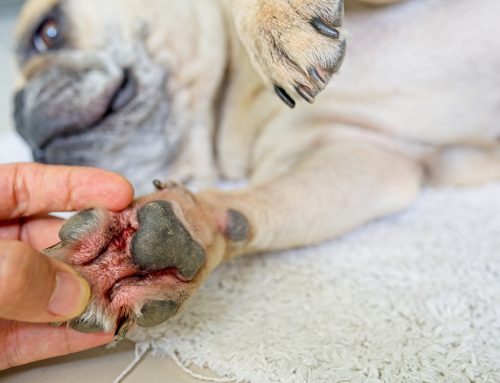Laser surgery uses special light beams rather than instruments to perform surgical procedures, and provides many advantages for pets when compared with traditional surgical methods. Our Smithtown Animal Hospital team is pleased to offer this technology. Learn about veterinary laser surgery and how your pet can benefit.
What is veterinary laser surgery?
Laser, which is an acronym for Light Amplification by the Stimulated Emission of Radiation, is an optoelectronic device that produces highly concentrated light rays. During laser surgery, a highly focused laser beam incises or removes living tissue. At the same time, the laser also seals capillaries, small blood vessels, lymphatics, and nerve endings. The most common laser surgery units use laser radiation emitted by carbon dioxide (i.e., CO2 laser). The CO2 laser has a 10.6-micrometer (μm) wavelength, which water can absorb. Soft tissue is greater than 90% water, so the CO2 laser is effective on all soft tissue, regardless of the tissue’s pigmentation. Water in the target tissue absorbs the laser energy, causing the tissue to heat, boil, and vaporize. Soft tissue’s CO2 laser energy absorption is extremely efficient. The beam penetrates no more than 0.1 millimeters (mm) beyond the cut, and thermal injury under the cut is only 0.5 mm in depth, which allows the surgeon to have extremely precise control.
What are the advantages of veterinary laser surgery?
Many traditional surgery types can improve a pet’s condition. However, CO2 laser surgery has many advantages over traditional surgery, including:
- Reduced surgical bleeding — In traditional surgery, a veterinary surgeon uses a scalpel blade to make an incision. When the skin is incised, small blood vessels in the skin and tissue layer under the skin are cut, and these blood vessels can bleed during and after surgery. Surgeons typically apply pressure to the incision using gauze sponges or instruments, or cauterize the wound to control bleeding. During CO2 laser surgery, cauterization occurs simultaneously, as the laser beam incises the tissue.
- Decreased postoperative pain — Scalpel blade incisions leave raw nerve endings that can cause significant pain. CO2 lasers seal the nerve endings as the laser cuts the tissue, reducing pain impulses.
- Reduced swelling — CO2 laser surgery is less invasive than traditional surgery, resulting in less swelling.
- Decreased infection risk — The CO2 laser operates at temperatures higher than 200 degrees, destroying all bacteria at the surgical site, greatly reducing your pet’s infection risk.
- Increased visibility — Bleeding can interfere with a surgeon’s ability to see the surgical field. The CO2 laser’s ability to cauterize vessels provides increased visibility during the surgical procedure.
- Increased precision — The CO2 laser can be adjusted to remove only a single cell layer at a time, increasing a surgeon’s precision.
- Reduced surgical time — In many cases, the CO2 laser’s hemostatic effect and improved surgical field visibility reduce the surgery time. This prevents your pet from needing anesthesia any longer than necessary.
- Decreased anesthesia need — In some cases, the CO2 laser prevents the need for anesthesia, because a surgeon can perform the procedure quickly, helping minimize your pet’s pain.
What procedures can be performed with veterinary laser surgery?

A veterinary surgeon can perform almost any soft tissue surgery using a CO2 laser. The CO2 laser is also extremely useful for performing surgery on tiny pets who can’t tolerate a lot of blood loss. Soft tissue surgeries in which the CO2 laser is beneficial include:
- Wound debridement — A veterinary surgeon can use a CO2 laser when debriding wounds, minimizing further damage and decreasing pain.
- Dermatologic conditions — A surgeon can use a CO2 laser to address dermatologic conditions such as acral lick granulomas, cutaneous masses, skin tags, benign melanoma, squamous cell carcinoma, papillomas, and nodular sebaceous hyperplasia.
- Eyelid surgery — A veterinary surgeon can use a CO2 laser to correct conditions involving the eyelid, such as entropion and ectropion.
- Oral tumors — A surgeon can use a CO2 laser to remove or debulk oral tumors.
- Neuter — A veterinary surgeon can use a CO2 laser to neuter your male pet. Doing so reduces swelling and minimizes bleeding.
- Spay — A surgeon can use a CO2 laser when spaying your female pet. Doing so reduces bleeding and decreases anesthesia time.
- Nasal and ear surgery — A veterinary surgeon can use a CO2 laser for procedures inside the nose and ear canal.
- Bladder surgery — The bladder is highly vascular and can bleed significantly when incised. A surgeon can use a CO2 laser to perform bladder surgery, preventing bleeding and expediting the surgical time.
- Mammary tumors — Mammary tumors tend to be malignant and highly vascular, requiring substantial time during surgery to control bleeding. A veterinary surgeon can use a CO2 laser, allowing for exceptional bleeding control during the procedure.
CO2 laser surgery is an advanced technology that provides many benefits for pets. If your pet needs soft tissue surgery, contact our Smithtown Animal Hospital team, so we can determine if their condition makes them a good CO2 laser surgery candidate.







Leave A Comment